Republic of Kazakhstan
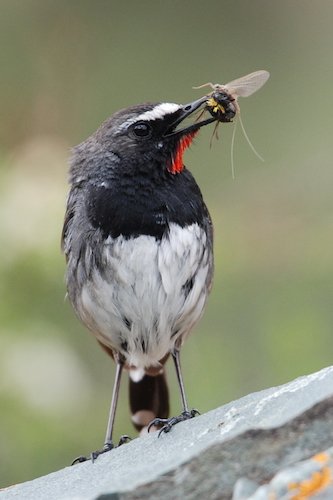
Kazakhstan is a landlocked country mostly in Central Asia, with a part in Eastern Europe. It borders Russia to the north and west, China to the east, Kyrgyzstan to the southeast, Uzbekistan to the south, and Turkmenistan to the southwest, with a coastline along the Caspian Sea. Its capital is Astana with 1.3 million inhabitants, while the largest city and leading cultural and commercial hub is Almaty where two million people (10% of the population) live. Kazakhstan is the world’s ninth-largest country by land area and the largest landlocked country. It has a population of 20 million and one of the lowest population densities in the world, at fewer than 6 people per square kilometre (16 people per square mile). Ethnic Kazakhs constitute a majority, while ethnic Russians form a significant minority. Officially secular, Kazakhstan is a Muslim-majority country with a sizeable Christian community.
It stretches almost 3,000km from the Volga Delta in the west to the west border of Mongolia in the east, and 1,600km from Russia in the north to Turkmenistan, Uzbekistan and Kirghizstan in the south. It occupies a territory of 2,700,000km2. Plains cover 60% of this territory, hummocks 30% and mountains and foothills 10%.
The Western Tien Shan, Northern Tien Shan, Dzungarian region and Altai are the largest mountain regions in Kazakhstan. About 34,500 lakes are scattered over the country and are most abundant in northern regions. Some of these lakes are intermittent. The largest and most famous are the Caspian Sea and the Aral Sea, and large lakes such as Balkhash, Zaisan, Alakol, Tengiz and Kushmurun. The majority of rivers such as Ural, Irgiz, Turgai, Sarysu, Nura, Ili etc. belong to the closed catchment-areas of large lakes. Only the rivers Irtysh, Ishim and Tobol flow to the sea (eventually) the Arctic Ocean.
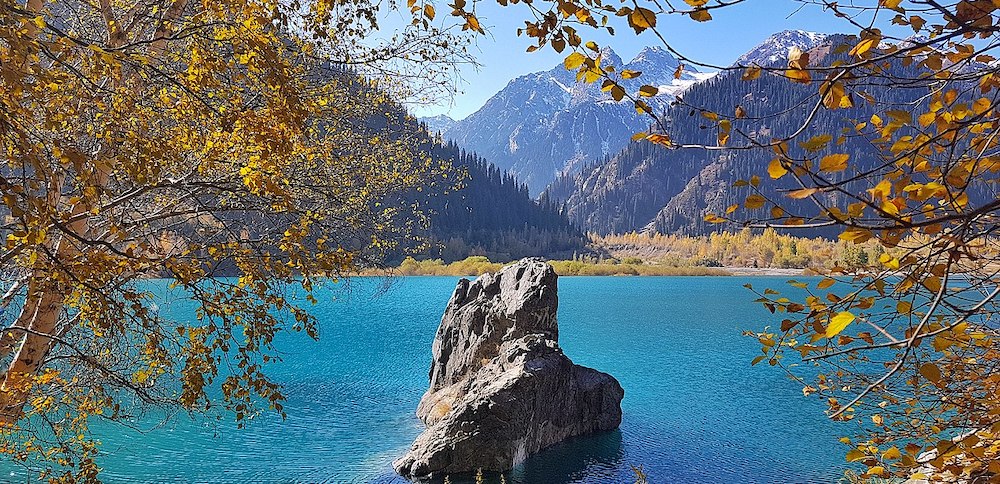
Ile-Alatau National Park – ©Timas38, CC BY-SA 4.0 via Wikimedia Commons
This typical inner-continental country has great diversity of landscapes: different types of steppes and north desert, deciduous and coniferous forests, large lakes, and river valleys, huge mountains with magnificent gorges and white-capped peaks. The northernmost region is represented by the forest-steppe ecosystems of the Western-Siberian Lowland. Further south, these ecosystems change for steppe ones followed by extensive desert covering over 44% of the total area of the country. The mountains belts include different types of forests, alpine meadows, tundra, permanent snow belts and glaciers.
Birding Kazakhstan
This geographical location and diversity provide a rich composition of flora and fauna with over 6,000 species of vascular plants and 835 vertebrate species. There are over 500 bird species recorded, including nearly 400 breeding species, the rest are migratory or wintering species. Some of them are familiar, but one may also encounter many wonderful and rare birds such as: Greater Flamingo, Red-breasted Goose, White-headed Duck, Griffon Vulture, Black Vulture, Imperial Eagle, Saker, Black Grouse, Siberian Crane, Great, Houbara & Little Bustards, Sociable Lapwing, Pallas’s, Black-bellied & Pin-tailed Sandgrouse, White-winged & Black Larks and many others. Among the c.178 species of mammals there are also very interesting species: Snow Leopard, Persian Gazelle, Saiga, Asian Wild Ass, Bukhara Red Deer, Argali and Ibex.
North-west Kazakhstan – Kostanay Oblast
Many regions of Kazakhstan are very interesting for birdwatchers. Kostanay oblast on the north-west of country is one of them. This region with steppe, lakes and forest patches, including Naurzum State Nature Reserve, have very diverse bird fauna, especially during migration time, and some special species that possible encounter only here, of which Black Lark and White-winged Lark are endemic of steppe of Central Asia.
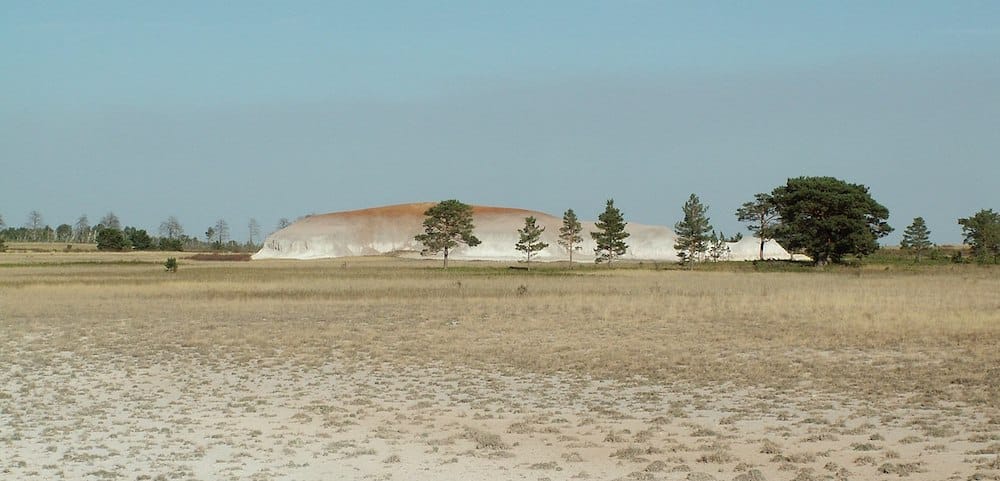
Naurzum Nature Reserve – ©Tomiris CC BY-SA 3.0 via Wikimedia Commons
Naurzum Reserve situated in the south dry steppe of Kustanai Oblast, but this region, together with typical landscapes, also has contrasting landscapes that attracted an extraordinary wealth of animals and world of vegetation. Steppe, lakes, meadows and forests create an interesting combination of habitats. Typical, short feather grass steppe and other variants occupy majority of this territory.
In the spring, a variety of flowers cover the steppe; afemerals and flowering adonises, Pulsatilla flavesceus, different tulips and irises. In June, the flowering feather grass transforms the steppe into a shimmering silver sea. Three forested areas are situated in different soil conditions that affect their composition and structure. Severe conditions of growth limits the number of tree species by pine, aspen and different species of birch. The pines are dispersed on multiple large and small sand hills, where they grow as small pine islands surrounded by steppe vegetation.
Numerous large and small, fresh and salt lakes, situated here, are intermittent. The species of different landscapes zones are found in the fauna of this area. The largest animal in the reserve is the Moose. Before 1990, in the summer, grazing herds of Saiga Saiga tatarica could be seen in steppe areas and would seek shelter among the Naurzum pines. Altogether the fauna is composed of 337 species: 44 mammals, 278 birds, 3 reptiles, 3 amphibians and 9 fish.
This area is the best place for observation of the Birds of Prey. Overall 25 raptor species, including 16 breeding ones, occur here. In the forests of the reserve raptors breed… 53 pairs of Golden, Imperial & White-tailed Eagles and many other birds of prey such as Saker, Red-footed Falcon, Kestrel, Hobby, Merlin etc. In steppe areas breed Steppe Eagle and Pallid & Montagu’s Harriers, on lakes its Marsh Harrier. Black Grouse, Golden Oriole, Oriental Turtle Dove, Great-spotted Woodpecker, Azure Tit, Swift, Redstart, Eagle and Scops Owls are some species typical in the forests. The Central Asian endemic species White-winged & Black Larks are abundant in some steppes, also Sociable Lapwing occur here as do Little Bustard & Demoiselle Crane. There are passerines too such as Wheatear & Isabelline Wheatear, in bushes one finds Barred & Booted Warbler, Red-backed & Lesser Grey Shrike (and, very rarely, Isabelline Shrike); Bluethroat and others. Some species like Roller, Hoopoe, Rose-coloured Starling may be encountered in different habitats.
Bird fauna is the richest and most diverse on or around the lakes with a lot of waterfowl, shorebirds and passerines. There are many interesting species: Dalmatian & White Pelicans White-headed & Ferruginous Ducks, Great Black-headed, Yellow-legged & Little Gulls, Gull-billed, Caspian, Black & White-winged Terns, as well as of more or less common waders and ducks and some passerine species – Paddy-field, Reed, Great Reed, Cetti’s, Savi’s Warblers, Reed & Red-headed Bunting, Bearded Tit and Stonechat occupying reeds and bushes around the lakes.
The lake is also famous for being a very important roosting lake of migratory birds, especially in the autumn. Hundreds of thousands of birds: geese (Greylag, White-fronted, Lesser White-fronted and Red-breasted); swans (Whooper, Mute and Tundra); different ducks and waders species found a rest and shelter here. Such rare species as Siberian Crane also make regular stops. The biggest night roost has been counted at 160,000 geese in one lake in October 1998. The best time of the year for bird watching is May and June, but for observation of arctic geese and other migratory birds – the end of September and beginning of October.
South Kazakhstan – Almaty Oblast
This region is very interesting, because it includes North Tien Shan Mountain with gorges, lakes, broad-leaf and spruce forest, the canyons of Charyn River, sandy and clay desert and wetlands – large and small lakes in the desert. The centre of the region Almaty is the largest and one of the most beautiful cities of Kazakhstan. It was first capital of the country. The bird fauna of North Tien Shan Mountain is very diverse, including nearly 200 species. These include: Lammergeier, Himalayan Vulture, Golden Eagle, Ibisbill, Himalayan Snow Cock and especially passerine – Blue Whistling Thrush, Blue-headed, and Eversmann’s Redstarts, Severtsov’s Tit Warbler, White-throated & Brown Dippers, Brown & Black-throated Accentors, Red-mantled Rosefinch, Himalayan Rubythroat, Red-fronted Serin, White-winged Grosbeak, Hodgson’s Rosy Finch, Alpine & Himalayan Accentors, Guldenstadt’s Redstart, Brandt’s Rosy Finch, Red-breasted Rosefinch.
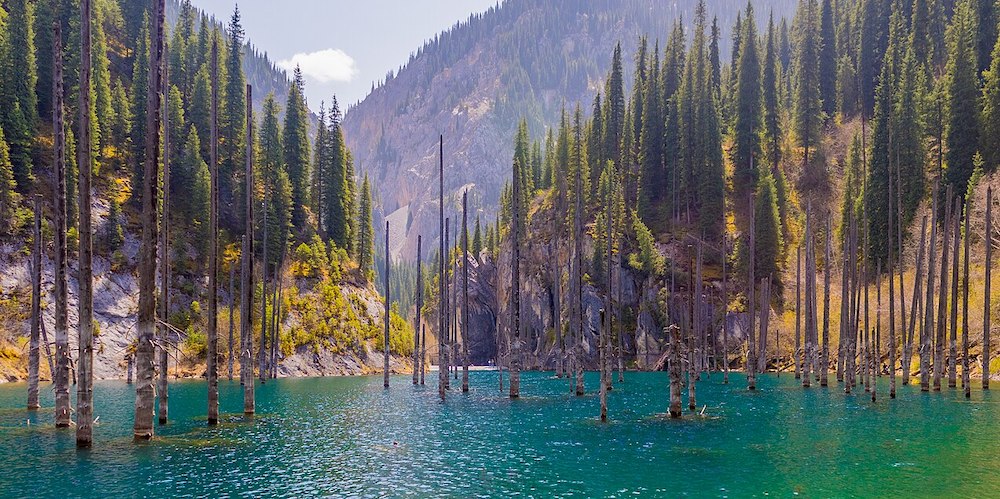
Kolsay Lakes National Park – ©Bok CC BY-SA 4.0 via Wikimedia Commons
The Canyon of Charyn River is a truly spectacular place. With surrounding area there are very specific bird fauna, which include some raptor species: Golden Eagle, Egyptian Vulture, Long-legged Buzzard, Saker Falcon, Lesser Kestrel and other birds such as Black Stork, Chukar, Short-toed, Bimaculated & Horned Larks, Isabelline & Pied Wheatears, Rock & Blue-rock Thrushes, White-capped, Grey-necked, Rock & Red-headed Buntings, Hoopoe, Roller, Rock Sparrow, Rose-coloured Starling, Mongolian Trumpeter Finch and Lesser Grey Shrike.
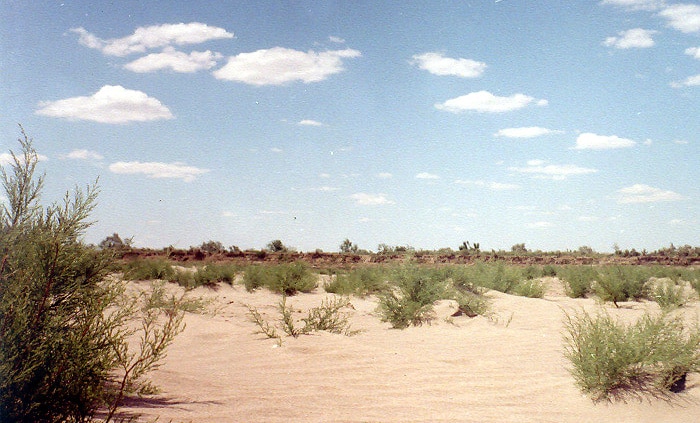
Taukum Desert – ©Eriss2, Public domain via Wikimedia Commons
The typical Northern type desert represented by Saryesik-Atyrau desert and Taukum desert. Saryesik-Atyrau is mainly sandy, where in some places have preserved Saxaul forest. In Taukum desert clay valleys and sand hills combine. There are some specific species like Black-bellied, Pintail & Pallas’s Sandgrouse Lesser Short-toed Lark, Desert Wheatear, Great Grey Shrike Blue-cheeked Bee-eater, Brown-necked Raven, Turkestan Tit, Saxaul Sparrow, Rufous Bush Robin, Desert Wheatear, Desert Warbler and very rare species – Short-toed Eagle & Pander’s Ground Jay. Bluethroat, Isabelline Shrike, Eversmann’s Dove and White-winged Woodpecker might be encountered in Turanga tree groves near Ili river.
The lakes of this region attract very many Water birds. There are Dalmatian and White Pelicans, different species of ducks, including White-headed & Ferruginous, Great Black-headed Gull, Gull-billed & Caspian Tern, waders with some interesting species like Caspian & Greater Sand Plovers, Collared Pratincole and some species of Warbler.
-
Chopak Ornithological Station
InformationSatellite ViewInstitute of zoology - Visitors to Chopak Ornithological Station gavr@zool2.academ.alma-ata.su Contact E.I. Gavrilov in Almaty.Chokpak ornithological station is a unique ornithological station in Kazakstan - the Asian part of former USSR which has been in existence since 1966. It is located in the foothills of Western Tian-Shan on the Chokpak Pass (1200 M above sea level) between Dzabaglytau and Boroldai Ridges being of part of Talassky Alatau. The work of the station is the study of bird migration. Catching and ringing birds is carried out daily, as well as visual accounts of migrants. This is by the use of large traps (height -12 M, width - 40 M, length - 65-70 M) of the Heligoland type. The maximum number of birds caught for one day has reached 14000 specimens. More than 2 million birds of more than 150 different species have been ringed since the station opened in 1966.Species include: Bee-eater, Nightjar, Red-headed Bunting, Rufous Turtle Dove, Roller, Spanish and Indian sparrows, Barn Swallow, Red-rumped Swallow and Sand Martin, Hobby, Rose-coloured Starling, Golden Oriole, and several different Wagtails all regularly caught in the spring. You can observe the migration of numerous birds of prey in the autumn. Some of them are caught with traps, for example: Shikra, Lesser Kestrel, Montagu's Harrier, Common Buzzard (subspecies japonicus); Long-legged Buzzard, & Honey Buzzard. When there is a halt in the trapping of birds, one can do fascinating excursions to small reservoirs: Ters-Astchibulak reservoir and Stone lake, where one can see concentrations of Demoiselle Crane and Ruddy Shelduck, Great Black-headed Gull, Red-crested Pochard and other waterfowl. You can visit the breeding places of Lesser Kestrel, Long-legged Buzzard, Egyptian Vulture, Short-toed Eagle, Eagle Owl, Black stork, Eastern Rock Nuthatch, Pied Wheatear, Bimaculated Lark, Bee-eater and Blue-cheeked Bee-eater, and colonies of a Rose-coloured Starling in the Karatau mountains.If you wish, it is possible to visit a reserve in the gorge Berkara with a unique area for of Paradise Flycatcher in spring. One day excursion can be devoted to the Natural Reserve Aksu-Dzabagly. It is located only in 20 km from our camp. Blue Whistling Thrush, Dipper and Brown Dipper, and other birds of the juniper forest can be watched there. In an area located in 1km from the camp, you can see White-winged Woodpecker, Long-eared Owl, Lesser Grey Shrike and Long-Tailed Shrike, various species of Warblers: Chiffchaff, Greenish Warbler, Yellow-browed Warbler, Lesser Whitethroat with subspecies S. c. curruca, S.c.telengetica, S.c. halimodendri, Grey Tit, Yellow-breasted & Azure Tit, etc. The field Camp consists of a large tent - kitchen, field laboratory and 8 sleeping places. Accommodation is available in the van or tent. The dates for visitors are: 20th April – 30th May, and 1st September – 30th October. Participants arrive at Almaty airport, then take 1-2 days in the city for registration (accommodation in hotel) and transfer to Chokpak station by car (12 hours duration); the distance between Almaty and Chokpak station being 600 km.
-
Number of bird species: 531
(As at July 2024)National Bird: Steppe eagle Aquila nipalensis
-
Avibase
PDF ChecklistThis checklist includes all bird species found in Kazakhstan , based on the best information available at this time. It is based on a wide variety of sources that I collated over many years. I am pleased to offer these checklists as a service to birdwatchers. If you find any error, please do not hesitate to report them. -
BUBO
ChecklistThe Checklist of Birds of Kazakhstan from the Birds of Kazakhstan website includes many splits not recognised by major authorities, so we prefer to use a Kazakhstan list based on IOC taxonomy. -
Kazakhstan Birdwatching Community
ChecklistThe Checklist of the Birds of Kazakhstan -
Wikipedia
Annotated ListThis list's taxonomic treatment (designation and sequence of orders, families and species) and nomenclature (common and scientific names) follow the conventions of The Clements Checklist of Birds of the World, 2022 edition. The family accounts at the beginning of each heading reflect this taxonomy, as do the species counts found in each family account. Accidental species are included in the total species count for Kazakhstan. -
eBird
PDF ChecklistThis checklist is generated with data from eBird (ebird.org), a global database of bird sightings from birders like you. If you enjoy this checklist, please consider contributing your sightings to eBird. It is 100% free to take part, and your observations will help support birders, researchers, and conservationists worldwide.
-
A Field Guide to the Birds of Kazakhstan
By Vadim Konstantinovich Ryabitsev, AF Kovshar, VA Kovshar & NN Berezovikov | BTS Print | 2014 | Hardback | 511 pages, colour photos, colour illustrations, colour distribution maps | Russian Text | ISBN: 9786017287153 Buy this book from NHBS.com -
Birds of Central Asia
(Kazakhstan, Turkmenistan, Uzbekistan, Kyrgyzstan, Tajikistan & Afghanistan) | By Raffael Ayé, Manuel Schweizer & Tobias Roth | Christopher Helm | 2012 | Paperback | 336 pages, 141 plates with colour illustrations; 14 colour photos, 5 b/w illustrations, 3 colour maps, colour distribution maps | ISBN: 9780713670387 Buy this book from NHBS.com -
Important Bird Areas in Kazakhstan
(Priority Sites for Conservation) | Edited by SL Sklyarenko, GR Welch & M Brombacher | RSPB | 2008 | Paperback | 314 pages, Figs, tabs, maps | ISBN: 9789965326868 Buy this book from NHBS.com -
The New Birds of Kazakhstan
By Arend Wassink | Arend Wassink | 2015 | Hardback | 382 pages, colour photos, colour illustrations, colour distribution maps | ISBN: 9789081146203 Buy this book from NHBS.com
-
Laboratory of Ornithology and Herpetology
WebpageAt the Republic of Kazakhstan Institute of Zoology
-
Association for the Conservation of Biodiversity of Kazakhstan (ACBK)
Facebook PageTo ensure the conservation and sustainable use of biodiversity of Kazakhstan -
Birding Kazakhstan
Facebook PageBirding Kazakhstan is devoted to anyone with an interest in birdwatching in Kazakhstan -
Kazakhstan Birdwatching Community
WebsiteThis site has been established as part of a collaborative initiative among birdwatchers in the post-Soviet space. Long-standing examples of similar local projects include websites like "Birds of Kazakhstan" or "Birds of Ukraine". The primary audience for this site comprises local birdwatchers. Should any local birdwatcher aspire not only to participate but also to take an active role in managing the site and influencing its policies, we invite you to reach out to us at info@birding.day.
-
*List of protected areas of Kazakhstan
InformationSatellite ViewNature Reserves -
NP Altyn-Emel
InformationSatellite ViewThe park serves to preserve rare and endangered plant and animal species. The flora of the Park includes 1800 plant species, including 69 rare species. Also, 56 animal species within the park are considered rare, including argali, dziggetai, Persian gazelle. Not counting insects and fish, at least 260 different animals live in Altyn Emel. There are endangered amphibians including the Siberian toad and rare and endangered birds including black stork and imperial eagle. Of 78 species of mammals, 11 are recorded in the Red Book of Kazakhstan, including stone marten, polecat, otter, manul (wild cat), wild ass, gazelle, argali, Asian barbastelle bat, Bukhara deer, lynx and Tien Shan brown bear. Kulan, goitered gazelle and Przewalski horses also live in the park -
NP Bayanaul
InformationSatellite ViewBayanaul National Park is located in southeastern Pavlodar Province, 140 kilometers from the industrially developed city of Ekibastuz, on the outskirts of the Central Kazakh Uplands. The park was Kazakhstan's first national park. It was created to preserve and restore the natural flora and fauna found in the Bayanaul mountain range. Its total area is 68,453 hectares. Around 50 species of bird and 40 species of mammals inhabit the park including cranes, bustard and a variety of birds of prey. -
NP Ile-Alatau
InformationSatellite ViewIt is situated in the mountains south of Almaty between Gorge Turgen in the east and Chemolgan River in the west. The National Park borders Almaty Nature Reserve, which is located around Peak Talgar. A total of 300 species of birds and other animals have been recorded in the park. It is home to snow leopards, Central Asian lynx, Tian Shan brown bears, Central Asian stone martens, Siberian ibex, bearded vultures and golden eagles. Other notable bird species include Himalayan snowcock, ibisbill, Eurasian scops owl, and Eurasian three-toed woodpecker -
NP Karkaraly
InformationSatellite ViewKarkaraly National Park is in the Karaganda Oblast (Karaganda Region) of Kazakhstan. There are 153 species of birds in the park. 11 of these species are in Kazakhstan’s Red Book of Protected Species. They are: golden eagle, imperial eagle, steppe eagle, booted eagle, saker falcon, Eurasian eagle-owl, Dalmatian pelican, black stork, whooper swan, swan goose, Pallas's sandgrouse. -
NP Tarbagatai
InformationSatellite ViewTarbagatai National Park was established in 2018 to protect a region of mountain-steppe in East Kazakhstan that supports stands of wild fruit trees that have been isolated from genetic encroachment by commercial varieties. The region is one of high biodiversity, with over 1,600 species of vascular plants identified, 270 of birds, 19 of fishes, 23 of reptiles, and 80 species of mammals. -
NR Aksu-Zhabagly
InformationSatellite ViewThis is the oldest nature reserve in Central Asia. It is located in the southern province of the Republic of Kazakhstan. It covers the north-western mountain chains of the Tian Shan. Its name is derived from the biggest river in the area, the Aksu, and the mountain chain Zhabagly which is located in the northern part of the area. There are 44 mammal species in the Reserve that are enlisted as highly endangered in the red book of Kazakhstan. The most prominent species are the snow leopard which is, however, rarely seen. Somewhat more frequent is the Himalayan brown bear, the Tien Shan argali (Ovis ammon karelini), the Indian crested porcupine (Hystrix indica), and Menzbier's marmot. -
NR Almaty State Natural Reserve
InformationSatellite ViewAlmaty State Natural Reserve is a 71,700 ha (177,000-acre) nature reserve in the Almaty Region, Kazakhstan, in the central part of the Trans-Ili Alatau ridge. -
NR BR WII Korgalzhyn
InformationSatellite ViewKorgalzhyn State Nature Reserve is in the Aqmola and Karaganda regions of Kazakhstan, located west of the city of Astana. It is made up of lakes, steppes and semi deserts. The biggest lake is Lake Tengiz. The wetlands are home to pelicans, cranes and the northernmost population of flamingos. Altogether there are more than 300 bird species in the reserve. The steppes of the reserve are home to wolves, saiga antelopes and bobak marmots. -
NR Barsa-Kelmes
InformationSatellite ViewBarsa-Kelmes Nature Reserve is a wildlife refuge on the former island of Barsa-Kelmes in Kyzylorda Region of Kazakhstan, in Central Asia. 203 bird species have been recorded in the area. -
NR Karatau
InformationSatellite ViewKaratau Nature Reserve is a wildlife refuge in the mid-part of the Karatau Mountains, near Kyzylkum, Betpak-Dala and Moiynkum deserts in the South Kazakhstan Region of Kazakhstan. 118 bird species have been recorded in the area. -
NR Naurzum
InformationSatellite ViewNaurzum State Nature Reserve is situated in the Naursumskiy and Semiozernyi districts, 200 km south of Kostanay city. It includes dry steppes with isolated forest patches and lake systems, in the central part of the great Turgay depression. There is a large number of fresh- and brackish-water lakes that resemble flat round kettles with a depth of usually no more than 2.5-3 m; they are dependent completely of spring flood water. The types of steppe here are: feather grass steppe, herb-bunch-grass steppe and different types of salt steppe and meadows. There are 47 species of mammals, 279 species of birds, 10 species of reptile and amphibious animals and 10 species of fish reported in the reserve. In addition more than 1000 species of invertebrates are found. -
NR Ustyurt
InformationSatellite ViewThe reserve has an area is 223,000 hectares (2,230 km2), and lies within Ustyurt Plateau, near the borders with Uzbekistan and Turkmenistan. Its purpose is to preserve the deserts as well as the rare flora and fauna.
-
eBird
SightingseBirding This Month
-
Bird Photo Tours ASIA
Tour OperatorBird-Photo-Tours Asia' Kazakhstan expedition will look to produce close photographic encounters with many of Kazakhstan’s special birds including Sociable Lapwing, White-winged Lark and Black-winged Pratincole in the Akmola Region to Pallid Scops Owl, Rufous-tailed Scrub Robin and Syke’s Warbler in the Zhambyl Region and to Caspian Plover, Black-bellied Sandgrouse and Desert Warbler in the Almaty Region. -
BirdFinders
Tour OperatorSituated on one of the Silk Roads, Kazakhstan has a huge diversity of habitats ranging from barkhans to the Tien Shan Mountains. We have an unsurpassed knowledge of the country and its birds, which include Himalayan Snowcock and Ibisbill in the mountains, Caspian Plover in the steppes, Mongolian Finch in the canyons and Pallas’s Sandgrouse and Saxaul Sparrow in the deserts. There is a post-tour extension for Black and White-winged Larks. -
BirdQuest
Tour OperatorMagical spring birding in Kazakhstan, Uzbekistan and Turkmenistan -
Boletas Birding
Tour OperatorDalmatian Pelican, McQueen's Bustard, Himalayan Griffon, Cinereous Vulture, Pallid Harrier, Saker, Great Black-headed Gull; Ibisbill; Black-winged Pratincole, Caspian and Greater Sand Plovers, Pallas's Sandgrouse, Himalayan Snowcock, Demoiselle Crane, Oriental Turtle-dove, White-winged Woodpecker... -
Calidris Birding Tours
Tour OperatorKazakhstan & Kyrgyzstan Birding Tour with Uzbekistan pre-trip extension -
Ecotour kazakhstan
Tour OperatorSteppes, forests, deserts and semideserts, picturesque lakes and high mountains of Kazakhstan give shelter to a great number of birds: about 500 species can be seen in different seasons; they represent 214 genuses, 60 families and 18 orders. You can see 13 species of a lark, 19 types of bunting and 59 types of sandpiper (plover). -
NatureTrek
Tour OperatorA 13-day birdwatching holiday to Kazakhstan and the remote highlands of Kyrgyzstan for some of Central Asia's best birding. -
Oriole Birding
Tour OperatorIn the heart of Central Asia, we find the attractive countries of Kazakhstan and Kyrgyzstan (Kirgizia). For a long time, known for their wide variety of rare Western Palearctic species and alluring steppe species like Black Lark and White-winged Lark... -
Rockjumper
Tour OperatorWe currently have no scheduled tours running in Kazakhstan. Have you considered contacting our Tailor-made tours department instead? -
Rubythroat Birding Tours
Tour OperatorRubythroat Birding Tours offers all-inclusive, high quality bird watching andnature holidays in Central Asia. We organize fixed departure tours as wellas private, customized tours for small groups. We can organise all toursof our travel programme for small groups, birdtour companies and evenprivate tours are possible. All tours are lead by local experts and/orEuropean top-ornithologists. Come and join us for an unforgettableexperience across the Kazakh mountains, steppe and deserts in search offWP most sough after species! -
Silk Road Birding
Tour OperatorJoin us in discovering a fascinating region and its fantastic birdlife -
Tropical Birding
Tour OperatorKazakhstan, Kyrgyzstan & Uzbekistan - Birding Tour -
WINGS
Tour OperatorCentral Asia: Uzbekistan and Kazakhstan Birding the Silk Road
-
2015 [05 May] - John van der Woude
Report...We did well on nearly all target species, but somehow the waders were in low numbers in the Astana region (which can hold large numbers in this time of year). So we often heard our local guide Aleksej saying "Wo sind die Limikolen?!" (Where are the waders?!). -
2017 [06 June] - Vaughan Ashby - Northwest Kazakhstan
PDF Report -
2019 [05 May] - Nick Upton
ReportMy 2019 birding tour to Kazakhstan was one of the best I have led over the last few years; incredible landscapes and non-stop fantastic birds made it hard not to enjoy every moment. -
2019 [06 June] - Rockjumper - Kazakhstan & Uzbekistan
PDF ReportThis was the first Rockjumper tour to Uzbekistan and Kazakhstan. The tour covered varied biogeographical zones and the bird specialities across these two land-locked countries. From the deserts of Kyzylkum in Uzbekistan and Taukum in Kazakhstan, through steppes and wetlands to mountains of anti-Pamir in Uzbekistan and Tien Shan in Kazakhstan, the tour connected with some of Central Asia's most sought-after species, enjoyed fantastic scenery and tasted from the rich cultures and histories of the region. -
2020 [01 January] - Sofia Broström
PDF ReportMy son and I visited Almaty for one week in the winter of 2020. We were curious about what the region would have to offer at this time of year, focusing on exploring the Ile-Alatau National Park as well as the rural areas located in the foothills of the Tien-Shan mountains surrounding the city. There was snow but not so much as to cause any problems such as closed roads. Temperatures were well below zero at night, and most often below zero also during the daytime, although twice we experienced rainfall. -
2021 [06 June] - Bassel Abi Jummaa - Nur Sultan Steepes
PDF ReportSince I started working in Kazakhstan back in 2018 and I had been always eager to travel around this prime birding destination in pursuit of its special bird species and stunning nature. From the central Asian semi deserts in the south to the northern steppes and the eastern mountain ranges , Kazakhstan offers plenty for birdwatchers and acts as a biodiversity hotspot in the very heart of Eurasia and a breeding stronghold to many Eurasian bird species . In addition it hosts several of the region’s sought after and breeding regional specialities notably the endangered sociable lapwing, Saker falcon, Turkestan ground jay and black-headed penduline tit not to mention other avian species of central Asian origins. -
2022 [07 July] - Oscar Campbell - Northern Kazakhstan
PDF ReportThis short trip report covers an independently organized birding trip to Astana (= Nursultan), Kazakhstan, in July 2022. The main objective was, of course, a visit to the Korgalzhyn area, c125km east of Astana, which was predictably fantastic, but we also visited the Burabay area c220 km north of Astana as well. This was also well worthwhile, despite our time there being curtailed by a late change in flight schedule... -
2024 [05 May] – Andy Smith
PDF ReportBlue Whistling Thrush, Azure Tit, Meadow Bunting, Himalayan Snowcock, Güldenstädt’s Redstart, Himalayan Rubythroat, Ibisbill, Yellow-eyed Pigeon, White-winged Woodpecker, Turkestan Tit, Saxaul Sparrow, Himalayan Griffon, Shikra and Oriental Honey Buzzard were just a few of the highlights of this special 13-day tour.
-
Birds of Kazakhstan
WebsiteThe main goal of the site - promoting birdwatching and creation of a culture of birdwatching in the post-Soviet space and other regions. In the world, millions of people are involved in birdwatching, and these are not always observers and photographers, there are tour organizers, guides, and sellers of feeders, perches, binoculars, other optics, there are special points for bird watching. Unfortunately, we don't have this yet.


